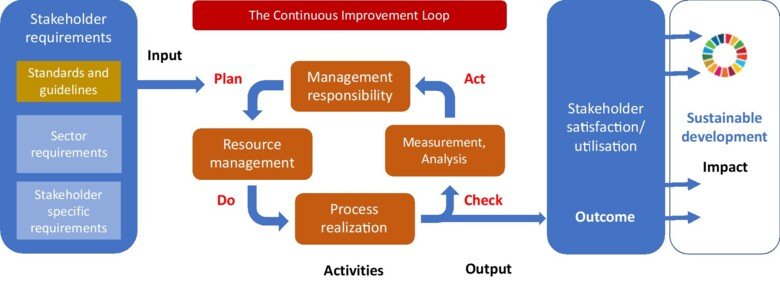Models for quality assurance and quality development
Operationally adapted models for quality assurance and quality development are now being developed for the universities' assignments - research, education and collaboration.
In a large multi-university project, KI is strengthening ongoing work to increase the societal impact of the organization. New organizational-adapted models for quality assurance and quality development have been developed, to facilitate the work of building a robust integrated quality system geared towards fulfilling the universities assignments.
A quality system based on stakeholder perspectives
A quality system is always based on the needs of stakeholders, both internal and external, and is evaluated based on their perceived quality. A quality assurance system works towards predefined quality goals, parameters and properties that are considered to be of good quality.
There are three tested models to conduct, in cooperation with an external actors, fair and relevant assessments of the results and effects of a collaboration.
- Partnership Canvas
- Laddering
- Workshop model
Focus on processes and impact
Collaboration is a means of developing our organization. By following up, analyzing and improving the collaboration processes, we create better impact through our shared knowledge assets.
- Emphasize how instead of what!
- Focus on value-added impact, instead of performance-based activity indicators
The continuous improvment loop

A quality evaluation reveals collaboration
Based on the overall experience, a self-evaluation gives a snapshot of collaboration and utilization.
The evaluation should also include an overall picture of the strategy of the Higher Education Institutions (HEI) for planned utilization, otherwise there is a risk that the evaluation will be reduced to anecdotal descriptions and do not contribute effectively to long-term quality development.
There are new guidelines for developing so-called Impact Case Studies, which:
- shows how research can be utilized, strengthens the credibility of the research community and the attractiveness of the educational HEI
- provides a basis for assessing collaboration and utilization, monitoring results and effects of stakeholders' perceived value
An evaluation of quality highlights the role of collaboration
An evaluation provides a snapshot of collaboration and utilization, but should also include an overall picture of an HEI’s strategies and processes for planned impact. Otherwise, there is a risk that the evaluation will be reduced to anecdotal descriptions that do not contribute to a long-term quality evaluation.
The evaluation should also include an overall picture of the institution's strategy for planned utilization, otherwise there is a risk that the evaluation will again be reduced to anecdotal descriptions and do not contribute effectively to long-term quality development. Evaluations cannot replace systematic quality evaluations.
Utilization goals designed for the situation
It is important to take into account that each HEI, and subsequently each field of science has different conditions and approaches to achieve utilization. All research does not follow the same trajectory, all results do not lead to immediate impact or immediate impact, so utilization needs to be highlighted in both the short and long term.
Case studies for follow-up and effect analysis
There are new guidelines for developing descriptive case studies, so-called Impact Case Studies, which:
- show how research can be utilized, strengthens the credibility of the research community and the attractiveness of the HEI
- provide a basis for assessing collaboration and utilization, in addition to monitoring results and effects of stakeholders' perceived value
Contact
If you have questions about the quality system and quality assurance system with external partner, please contact:
